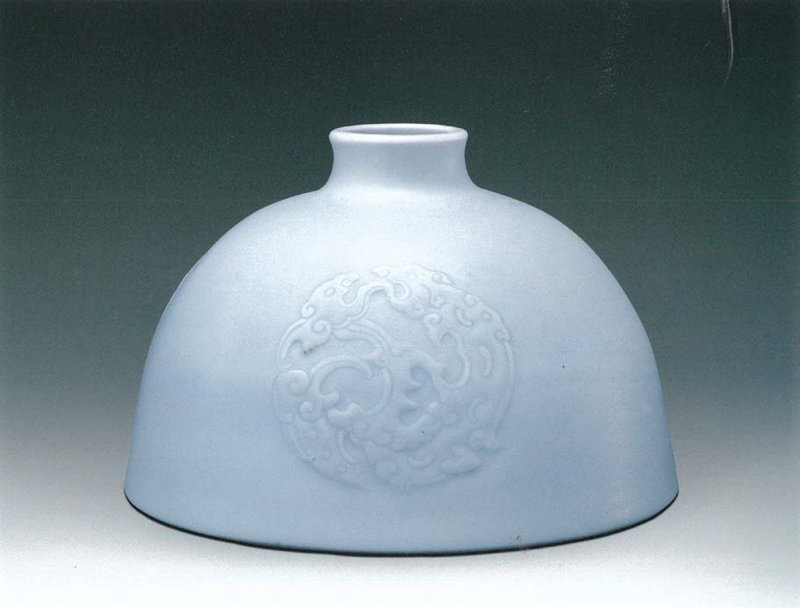A fine and very rare carved celadon-glazed ‘chilong’ vase, Qianlong six-character seal mark and of the period (1736-1795)
Lot 2910. A fine and very rare carved celadon-glazed ‘chilong’ vase, Qianlong six-character seal mark in underglaze blue and of the period (1736-1795); 9 1⁄8 in. (23.2 cm.) high, box. Price realised HKD 18,850,000 (Estimate HKD 3,500,000 - HKD 4,500,000). © Christie's 2021
The baluster vase is exquisitely potted with a tapered body rising to a waisted neck and a flared mouth. The exterior of the body is finely moulded with two medallions each containing three chilong, one with a foliate tail, the other two with bi-furcated tails, below a pendent ruyi collar, a band comprising florettes and dots, and a wide band of upright plantain leaves interspersed with florettes and dots. The lower body of the vase is similarly moulded with bands of plantain leaves and florettes.The baluster vase is exquisitely potted with a tapered body rising to a waisted neck and a flared mouth. The exterior of the body is finely moulded with two medallions each containing three chilong, one with a foliate tail, the other two with bi-furcated tails, below a pendent ruyi collar, a band comprising florettes and dots, and a wide band of upright plantain leaves interspersed with florettes and dots. The lower body of the vase is similarly moulded with bands of plantain leaves and florettes.
Provenance: The J.M. Hu (1911-1995), Zande Lou Collection.
Literature: Helen D. Ling and Edward T. Chow, Collection of Chinese Ceramics from the Pavilion of Ephemeral Attainment, vol. III, Hong Kong, 1950, pl. 183.
Exhibited: Shanghai Museum, Beijing Museum, Art Museum, The Chinese University of Hong Kong, Qing Imperial Monochromes. The Zande Lou Collection, 2005, Catalogue, pp. 116-117, no. 41.
Note: The present vase ranks among one of the finest celadon-glazed vessels produced during the Qianlong period. While celadon-glazed vessels were popular during the Qianlong period, it is very rare to find one with such exquisite moulding and superb quality of glaze, in fact, no other vase of the same design appears to have been published.
Monochrome vessels with carved ‘chilong’ medallions appeared as early as the Kangxi period, for example, compare a white-glazed water pot, taibaizun, carved with similar ‘chilong’ medallions in low-relief in the Palace Museum, Beijing, illustrated in Gugong bowuyuan cang Qingdai yuyao ciqi, vol. 1-1, Beijing, 2005, no. 119 (fig. 2). While chilong medallions are also found on peachbloom-glazed water pots from the Kangxi period, they are incised in intaglio rather than carved in low relief, see for example the Kangxi vase in the National Palace Museum, Taipei, illustrated in Catalogue of a Special Exhibition of Qing Monochromes, Taipei, 1981, no. 3.
fig. 2 A white-glazed water pot, taibaizun, Kangxi period, Collection of the Palace Museum, Beijing.
It is also interesting to compare the present vase to celadon-glazed vases carved with dragons and waves from the Kangxi period, which share a similar combination of low-relief carving and glaze colour, although in a more greyish tone than their successors, see the examples in the Palace Museum, Beijing, ibid., nos. 112 (fig. 3) and 113, and one sold at Sotheby’s New York, 16 September 2014, lot 156.
fig. 3 A celadon-glazed ‘dragon’ vase, Kangxi period, Collection of the Palace Museum, Beijing.
Christie's. Important Chinese Ceramics and Works of Art, Hong Kong, 3 december 2021

/https%3A%2F%2Fprofilepics.canalblog.com%2Fprofilepics%2F1%2F0%2F100183.jpg)
/https%3A%2F%2Fstorage.canalblog.com%2F03%2F02%2F119589%2F96711876_o.jpg)
/https%3A%2F%2Fstorage.canalblog.com%2F11%2F31%2F119589%2F94773502_o.jpg)
/https%3A%2F%2Fstorage.canalblog.com%2F20%2F83%2F119589%2F94772815_o.jpg)
/https%3A%2F%2Fstorage.canalblog.com%2F26%2F72%2F119589%2F75604929_o.jpg)
/https%3A%2F%2Fstorage.canalblog.com%2F59%2F60%2F119589%2F26458628_o.jpg)








/image%2F1371349%2F20240402%2Fob_7227e1_129-1.jpg)
/image%2F1371349%2F20240329%2Fob_2076ee_113-1.jpg)
/http%3A%2F%2Fstorage.canalblog.com%2F92%2F58%2F119589%2F129772574_o.jpg)
/http%3A%2F%2Fstorage.canalblog.com%2F50%2F04%2F119589%2F129632031_o.jpg)